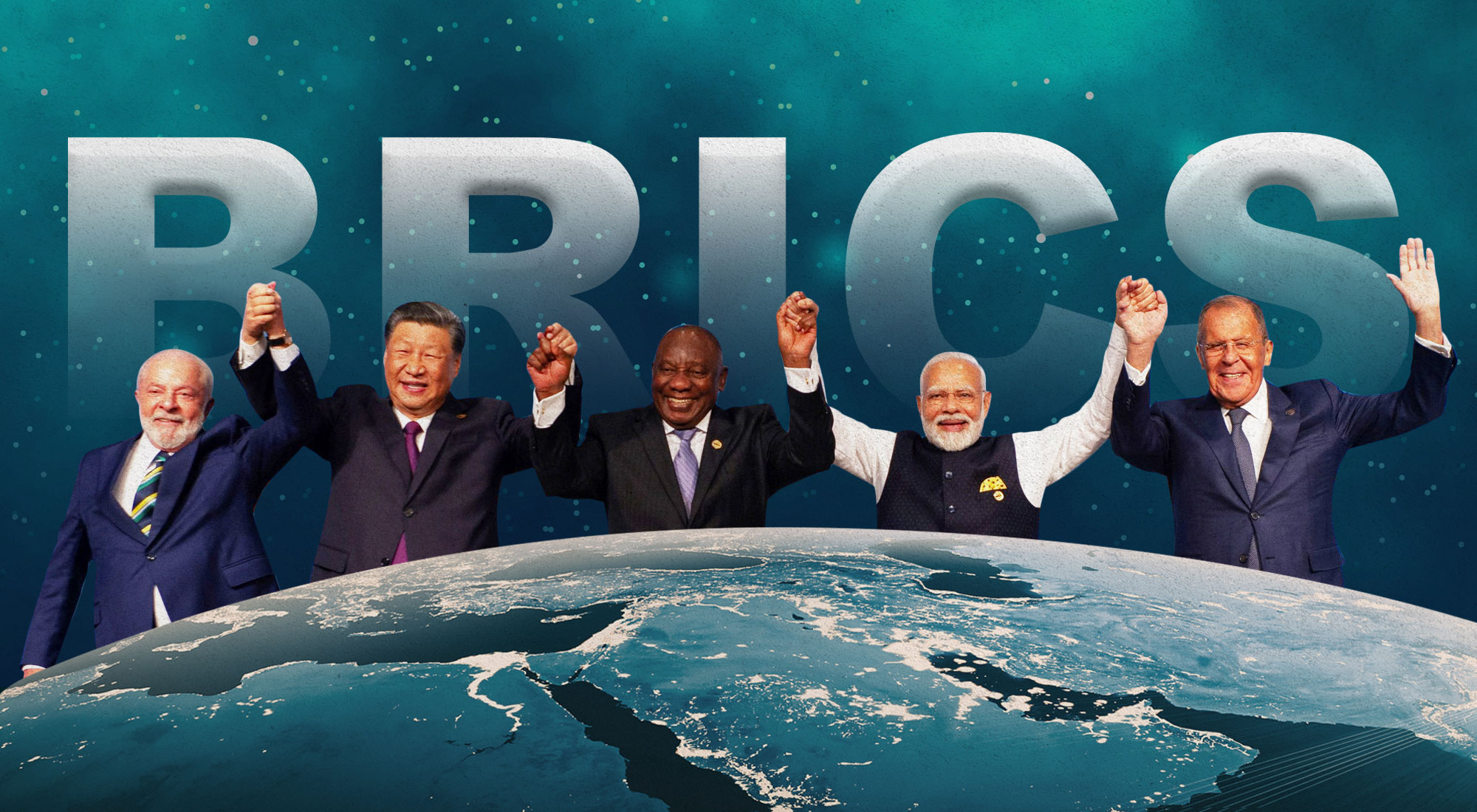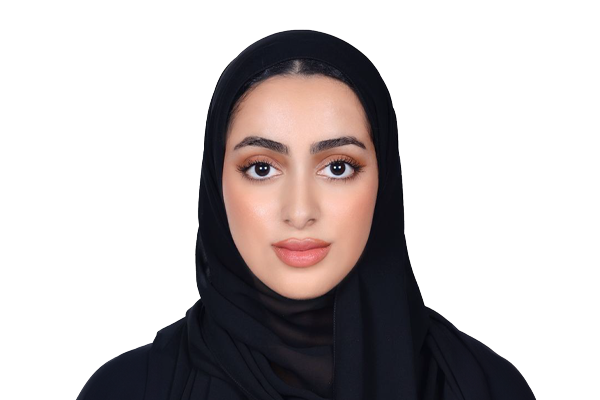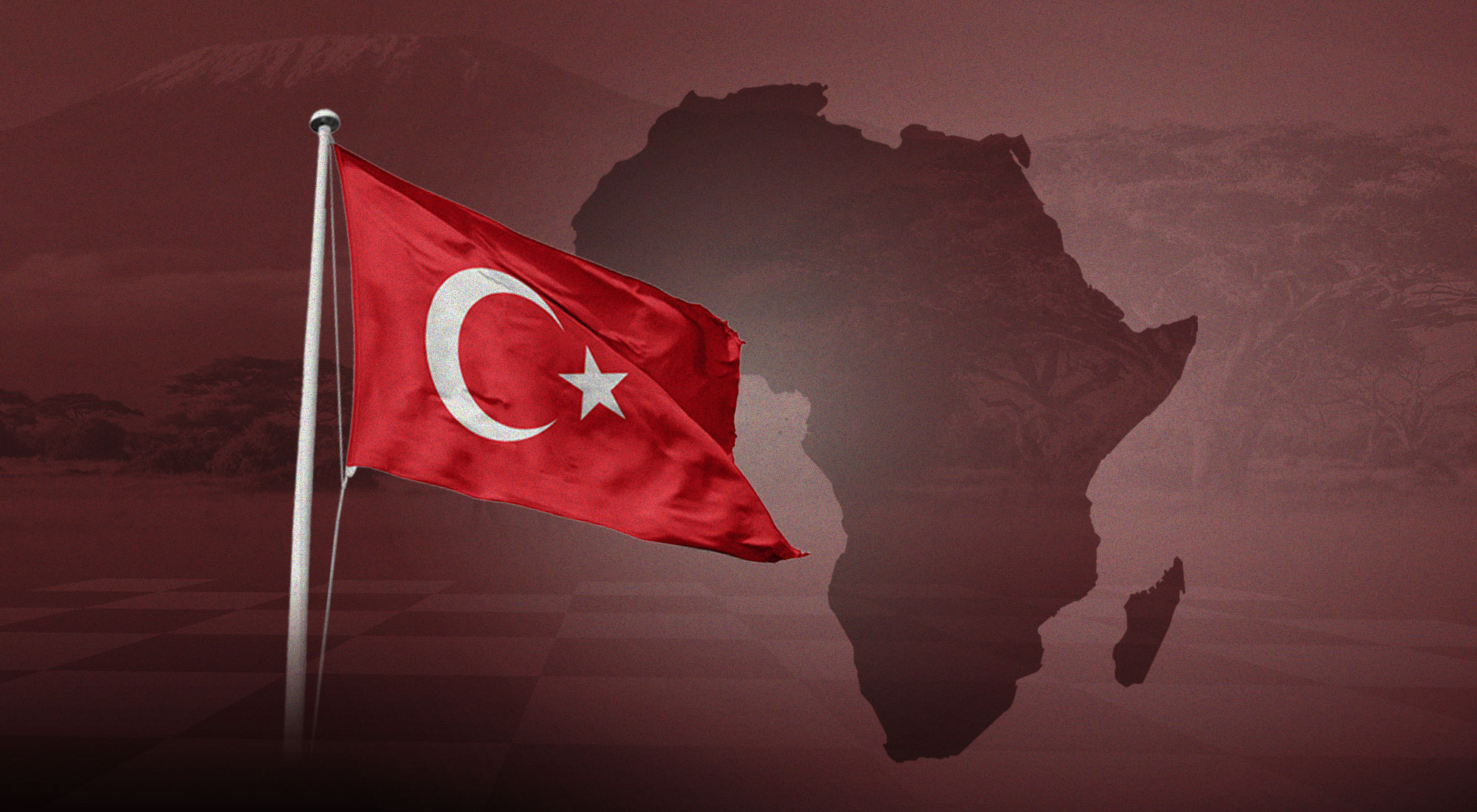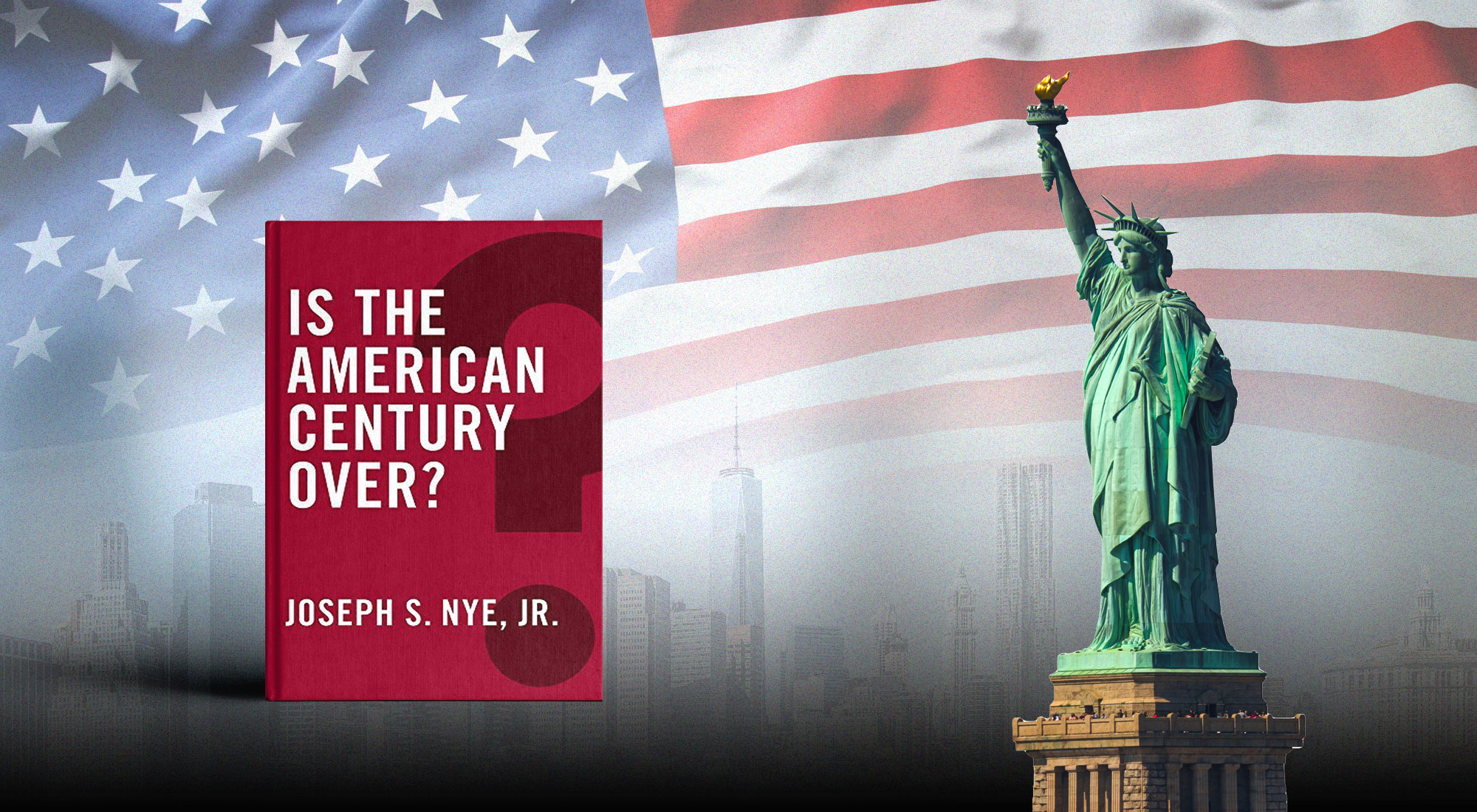The BRICS group, originally comprised of Brazil, Russia, India, China, and South Africa, emerged as a significant force in global economics and geopolitics in the early 21st century. Formally established in 2006, BRICS initially aimed to leverage the collective economic potential of its diverse member nations to influence global financial policies and promote mutual development. On 1 January 2024, the UAE, along with Egypt, Iran, and Ethiopia, joined the BRICS, increasing its membership to ten, marking a significant milestone in global trade and international economic relations.[1] According to announcements by other BRICS members, Saudi Arabia apparently also joined in this latest intake, but Saudi officials have since clarified that they are still considering the invitation.[2]
In the early stages, the focus of this cooperation between BRICS and the Gulf Cooperation Council (GCC) states was primarily on economic and energy-related matters, as GCC countries sought to diversify their economies beyond oil and gas exports while BRICS nations aimed to secure stable energy supplies. For instance, Saudi Arabia and the UAE developed close ties with China and India through substantial investments in infrastructure and energy projects.[3] Meanwhile, Qatar and Russia strengthened their relations within the gas sector, sharing interests as leading global producers.[4]
Formal engagements between BRICS and GCC states began in 2021, with the UAE becoming a member of the BRICS’ New Development Bank (NDB). This step marked a significant milestone in fostering closer ties between the two groups. The collaboration was further strengthened with the UAE’s and Saudi Arabia’s invitations to join BRICS in 2023, signaling a new phase in their relationship.
Following the rapidly rising Chinese and Indian shares of global GDP over the late 2010s and the new economic institutions and frameworks offered by BRICS and its members, like the NDB and the Belt and Road Initiative (BRI), the GCC countries increasingly viewed BRICS as a strategic counterweight to Western-led institutions such as the G7 and the World Bank. This shift was driven by a desire to diversify trade partnerships and explore new avenues for economic growth in an increasingly multipolar world. The financial crisis of 2008 and subsequent economic disruptions underscored the vulnerabilities of relying solely on Western markets and institutions, prompting GCC states to deepen their engagement with BRICS members.[5] This momentum led to some GCC states showing keen interest in joining the bloc—this interest rose notably after the onset of Western sanctions on Russia following its Ukraine invasion in 2022—and they view BRICS as a platform to amplify the voices of emerging and developing nations, addressing the disparities between the Global South and the North.[6]
Clearly, there is a complex interplay of economic, political, and strategic considerations that shape the engagement between GCC states and BRICS. By analyzing the varying perspectives of individual GCC countries, we can gain valuable insights into the current and potential future strategies they will pursue vis-à-vis the BRICS. The consideration and analysis of these GCC perspectives are the focus of this article. The following analysis will unfold over three levels. The first is the macro level, where GCC thinking regarding the broad geopolitical and economic opportunities and challenges that are shaping their current and likely future approaches to BRICS will be considered. The second is the meso level. Here, the analysis will look into more contained issues at the institutional level—particularly financial and energy-related, as well as the institutional coordination challenges facing BRICS—that are likely front of mind for GCC states as they move forward with their engagement with the bloc. Lastly, there is the micro level, where the specific business and investment opportunities and risks that BRICS engagement poses for GCC states will be unpacked.
The article will often refer to “GCC thinking” or the “GCC perspective” toward BRICS or make mention of how issues apply to the GCC. It needs to be noted that there is not a formal relationship between the GCC, as a bloc, and BRICS, nor indeed are there formal ties between all GCC states and BRICS—only the UAE has formally joined thus far. However, there is a relatively common set of opportunities and challenges that BRICS engagement poses for most of the GCC states. Accordingly, for the purposes of brevity and avoiding unwieldy language, this analysis will often refer to the GCC in the collective while also often making specific reference to the two GCC states whose engagement with BRICS has been by far the most substantial: the UAE and Saudi Arabia. For the same reasons, statements like “GCC states view BRICS as an opportunity to do x…” are largely referring to how GCC states might be viewing potential opportunities that could arise through BRICS membership, seeing as only the UAE has formally joined.
Section 1: Macro level (geopolitical and economic strategy)
1.1. Opportunities and challenges regarding geopolitical diversification and multipolarity
Reducing dependence on traditional Western allies and enhancing strategic autonomy
The GCC states are increasingly pursuing a multi-vector foreign policy approach, recognizing the shifting global power dynamics and the transition away from unipolarity.[7] This strategic reorientation is driven by the desire to balance relations between their traditional Western allies and rising powers, particularly China.[8] BRICS membership presents a significant opportunity for the GCC states to diversify their diplomatic and economic relationships, reducing over-dependence on any single partner while enabling them to maintain productive relations across geopolitical divides.[9] Indeed, the escalating U.S.-China rivalry poses a risk of forcing GCC states into choosing between the two sides in their respective bilateral relations—a clearly undesirable situation vis-à-vis the GCC’s development and security aims and interests. By engaging with BRICS, the GCC can potentially avoid this predicament and maintain a more balanced position in the international arena.
A further benefit of BRICS for the Gulf is that it provides a platform for the GCC states to play a more prominent role in shaping global governance structures. As relatively smaller powers, aligning with other emerging economies through BRICS would allow them to amplify their voice on the world stage. Here, BRICS membership could give more credibility and influence to the GCC states in shaping global economic and political agendas, allowing them to pursue their interests more assertively.
This multipolar shift also offers the GCC states an opportunity to increase their diplomatic and political leverage. By aligning more closely with major non-Western powers like China and Russia through BRICS, the GCC states could gain additional leverage in their dealings with the West. This “hedging” strategy allows them to play different powers off each other and potentially extract more favorable terms in areas such as security cooperation and arms sales.[10]
Furthermore, BRICS membership could enable the GCC states to gradually diversify their security relationships beyond their traditional reliance on the United States. While the U.S. remains the primary security guarantor for the Gulf, countries like China and Russia could become more significant arms suppliers and military partners over the long run.[11] This diversification not only reduces dependence on any single source but also potentially provides access to technologies that Western allies may be reluctant to share. There are notable barriers facing too extensive a shift in this direction in the short term, however, given the increasing willingness the U.S. is now showing to use access to its essential technology as leverage to prevent the GCC’s ties in sensitive areas with nations adversarial to the U.S. developing further.[12]
Aligning with the emerging multipolar world order
The GCC countries, particularly Saudi Arabia and the UAE, are strategically positioning themselves within the evolving multipolar global system.[13] This alignment is driven by several key factors, including the recognition of the shifting balance of power away from Western dominance and the growing influence of the Global South. Here, the GCC states are increasingly identifying themselves as part of the broader Global South, aligning their interests with other emerging economies.[14] Indeed, there has been a notable increase in diplomatic engagement between GCC states and other Global South countries over the past several years, with high-level visits and strategic partnerships occurring with increasing frequency across Africa and Asia. Furthermore, GCC states have been increasingly framing their international development and aid efforts within the context of South-South cooperation, emphasizing partnerships rather than donor-recipient relationships.[15]
Accordingly, BRICS membership could enable GCC states to position themselves advantageously as leaders within the Global South, enhancing their diplomatic leverage and presenting themselves as a bridge between the West and the developing world. The GCC, particularly countries like the UAE and Saudi Arabia, are uniquely positioned to act as influential bridges between the BRICS bloc and Western powers, potentially providing them with agenda-shaping power and unique influence over both sides. For instance, the UAE, with its geostrategic influence and strong economic ties to both China and the West, could position itself as an intermediary on matters related to global trade rules.[16]
Many GCC states have ambitions to be seen as influential middle powers on the global stage.[17] The abovementioned opportunity for shaping the new multipolar order that BRICS membership potentially presents could ensure that GCC states better achieve these ambitions. Furthermore, having a seat at the table in emerging power structures would better enable them to protect their interests in case of a relative decline in Western influence.
Challenges in pursuing geopolitical diversification
Despite the potential benefits, the GCC states face significant challenges in pursuing closer ties with the BRICS while maintaining their longstanding strategic relationships with Western powers, especially the United States. Moving too quickly or aggressively towards BRICS could strain relations with crucial Western partners and potentially jeopardize access to cutting-edge Western defense capabilities and support.[18] The GCC’s economies remain deeply intertwined with Western financial systems.[19] A significant shift towards BRICS could potentially lead to pushback against GCC economic interests tied to the West, including loss of access to key sources of foreign investment, potential sanctions, disruption to existing supply chains if barriers are placed around parts of Western markets, loss of foreign confidence in GCC currencies, rising investor concerns and subsequent capital flight leading to foreign exchange declines, exchange rate volatility if moves away from dollar pegs occur, and more.
A further challenge occupying the calculus of GCC states is the intra-BRICS conflicts that exist. However, the BRICS framework presents more opportunities than risks regarding these conflicts. For instance, BRICS provides a potential platform for Iran-Saudi dialogue and cooperation, which could help reduce tensions. BRICS provides opportunities for direct engagement between officials from both countries in a multilateral setting, meaning that there are more chances for issue linkage—a negotiation strategy that connects cooperation on one issue to cooperation on another issue[20]— due to the presence of the other BRICS members with vested interests in a stable Saudi-Iranian relationship. A further attractive dynamic of the intra-BRICS tensions is that the India-China rivalry within BRICS likely makes the grouping more appealing to GCC states, as it makes BRICS more multilateral, with more power centers, and less dominated by China alone. This rivalry means that GCC states can engage with BRICS without being seen as aligning too closely with China at the expense of relations with the West or India.
1.2. Opportunities and challenges regarding economic diversification and influence
Expanding trade and investment ties
GCC states are actively pursuing diversification of their economic ties, recognizing the benefits of engaging with multiple centers of global economic power.[21] This approach aims to reduce dependence on any single market or currency, access diverse sources of technology and investment, and enhance the GCC’s role in global supply chains. As part of this, the GCC is strategically rebalancing its oil exports away from the West and increasingly towards emerging Asian markets, with a particular focus on BRICS nations like China and India.[22] The GCC recognizes these nations as long-term customers for their energy resources but also sees potential for diversification beyond traditional oil and gas exports. Indeed, economic diversification for the GCC pertains not only to the diversification of partners but also to the diversification of domestic industries; nearly all GCC states have codified development visions that involve investing heavily in developing their manufacturing, technology, and services sectors to create new export opportunities.[23]
BRICS, with its stated goals of increasing economic cooperation among member states, presents significant market opportunities for expanding GCC non-oil exports and attracting foreign direct investment. A particular focus is on renewable energy, with BRICS membership potentially leading to deepening GCC cooperation with Chinese companies in renewable energy projects, both within the GCC and in third countries.[24] In laying the ground for this mode of BRICS cooperation, GCC states are leveraging their sovereign wealth to attract joint venture partners from the bloc’s countries.[25] This strategy aims to co-develop manufacturing facilities in GCC domestic markets, with a focus on sectors such as solar panel manufacturing and electric vehicle (EV) production.[26] Accordingly, BRICS collaborations will not only be key to GCC economic diversification but also to GCC sustainability goals.
Expanding economic influence in the Global South
BRICS membership provides the GCC with a genuine means to reshape their global image, moving beyond perceptions of being merely oil-rich nations to being seen as dynamic, forward-thinking global players actively contributing to South-South development. The UAE and Saudi Arabia have been investing substantially across Africa in the past few years, whether in port projects in Tanzania, solar projects in Angola, agricultural projects in Sudan, mining investments in Namibia, and more.[27] BRICS membership could facilitate more such investments across the continent and could accentuate this image shift discussed above.
The GCC states are uniquely positioned to act as intermediaries between BRICS and other developing nations, significantly increasing their strategic importance across the international community. This role could manifest in several ways. Firstly, the UAE could leverage its status as a global financial center to facilitate trade and investment flows between BRICS and other developing economies. Here, the UAE might be interested in creating specialized financial instruments or platforms tailored to South-South cooperation, such as trade finance platforms, commodity trading hubs, South-South fintech accelerators, and currency swap arrangements.
Secondly, Saudi Arabia and the UAE could position themselves as conduits for sharing expertise and best practices in areas like renewable energy, food security, smart city development, and digital transformation with other developing nations. Their experience in rapid modernization could be valuable for countries looking to leapfrog traditional development stages.
Thirdly, given their growing diplomatic clout, GCC states could play a crucial role in resolving conflicts or tensions between BRICS members and other developing nations. GCC states’ membership in BRICS would give them certain leverage over other BRICS members in conflict resolution contexts, and the GCC states’ already growing economic and diplomatic standing in the world would give them legitimacy and influence in the eyes of many developing nations. As an example, the UAE, which has strong people-to-people and economic links with both India and China, could see opportunities to use its growing leadership profile in the sustainability field to facilitate Indo-Chinese cooperation over shared issues like biodiversity loss and deforestation,[28] using this cooperative momentum to link to improving the direction of the India-China border dispute.
Many other such potential cases involving BRICS members abound, whether the Egypt-Ethiopia dispute over the Grand Ethiopian Renaissance Dam, the minor border dispute over hydroelectric power sharing between Brazil and Paraguay, illegal immigration tensions between Zimbabwe and South Africa, and more. Such efforts would not only give GCC states influence in these countries but could also open economic cooperation opportunities between them and the countries in question through the mediation process and would elevate the standing and leadership legitimacy of these GCC states across the Global South.
Challenges in economic diversification through BRICS
Despite the opportunities, the GCC faces several challenges in pursuing economic diversification through BRICS. Competition with BRICS countries in certain sectors, particularly manufacturing and technology, could pose a significant hurdle. Countries like China and India have well-established capacity in multiple areas that certain GCC states are looking to develop domestic manufacturing capacity in as pillars of their development strategies: cars (electric and traditional), advanced chemical manufacturing, and medium- and high-technology manufacturing being key examples.[29] Issues from these specific shared sectoral focuses have already proven problematic between certain GCC states and BRICS powers like China, as seen through the most recent cause of hold-ups to negotiations over the GCC-China free trade agreement. Accordingly, while BRICS absolutely poses opportunities to aid GCC economic diversification, it will not be a panacea, and GCC governments will be wary of the industrial dominance of BRICS manufacturing powers in key strategic sectors the former has identified.
The greater economic volatility that tends to define BRICS markets in relation to the GCC’s traditional Western economic partners will also be something GCC countries will be cognizant of in their calculations regarding to what extent they should consider integrating BRICS markets into their diversification strategies. Currency fluctuations and inflation/deflation can be more pronounced in BRICS economies, and such fluctuations or trajectories would, for instance, undermine prospective GCC investments or businesses operating in/with those countries and decrease the profitability of the trade contracts agreed to with those countries.
The notable political risks and new regulatory/business environments that define BRICS markets vis-à-vis the Western markets GCC states are more accustomed to are also factors GCC states will need to contend with when contemplating deepening their economic integration with BRICS members. For instance, countries like China have a much stronger state role in the economy compared to the GCC’s more market-oriented approach, and both markets also differ in areas like approaches to intellectual property and commercial dispute resolution.[30] Such disparities could create friction in joint ventures and investments. Furthermore, U.S. sanctions regimes on Iran and Russia significantly complicate the ability of GCC states to build investment relationships with both markets. Additionally, stock market volatility in countries like China could undermine prospective GCC sovereign wealth fund investments there.
1.3. GCC’s strategic calculus at the macro level
BRICS can offer Saudi Arabia and the UAE several unique opportunities beyond what they could achieve through bilateral relationships alone. These include diversification of partnerships, collective bargaining power, a structured platform for dialogue and negotiation, technology transfer and cooperation, and a platform for South-South cooperation. However, given the deep existing GCC-Western ties, any pivot towards greater geopolitical cooperation with BRICS would likely need to be gradual and carefully managed.
Indeed, Saudi Arabia and the UAE seem to be taking a calibrated approach to rebalancing their geopolitical alignments rather than a rapid pivot. This is evident in how they initially engaged with BRICS, accepting dialogue partner status in the Shanghai Cooperation Organization (SCO) before considering full BRICS membership. It is also clear through the multi-vector foreign policy approach they are employing—balancing their BRICS membership with strengthening ties with the U.S. in key strategic sectors, both economic and military.[31]
The GCC states are focusing on identifying key sectors for cooperation and competition. While energy exports and finance are heavily tied to Western systems, other areas like manufacturing or technology may offer more flexibility for new partnerships with BRICS nations. Nonetheless, industrial cooperation will not be unrestrained as GCC states, with their own industrial ambitions, go about ensuring their key strategic domestic industries are sufficiently protected.[32] Accordingly, GCC states are likely to focus on selective sector cooperation where complementarities exist, such as UAE-China cooperation on space technology. Looking past sectoral cooperation, GCC states will be particularly looking to leverage their strategic location and logistics infrastructure to become logistics and trade hubs between BRICS and other regions.
Section 2: Meso level (institutional and policy frameworks)
The institutional and policy frameworks within BRICS have evolved significantly since its inception in 2009, and the recent expansion to include four new members underscores its growing influence and ambition. Established after the global financial crisis in 2008, BRICS has positioned itself as a critical bloc advocating for reform in global governance and economic structures. The addition of countries such as the UAE, Egypt, Ethiopia, Iran, and potentially Saudi Arabia expands the coalition’s economic prowess, with projections indicating that BRICS now represents a substantial share of global GDP and critical resources such as oil and rare earth metals.
Russia took over the BRICS presidency on 1 January 2024, following on from South Africa’s chairmanship in 2023. This year’s summit will be held in the city of Kazan, Russia, in October, where the focus will be mainly on the de-dollarization agenda. Washington’s threat of secondary sanctions on financial institutions found to be facilitating Russia’s war effort gives momentum to de-dollarization. Russian Deputy Foreign Minister Ryabkov even announced that BRICS is preparing to establish its own central bank.[33] BRICS is an important platform for the GCC to diversify its trade partnerships, secure alternative access to finance, and hedge against changes in U.S. foreign policy towards the Middle East.
Experiencing rapid economic growth, the UAE and Saudi Arabia seek a more active role, international influence, and an independent regional status compared to their peers in the Gulf region. These oil-rich countries are determined to retain control of their political-economic future through careful balancing among multiple power centers as the world’s gravity shifts towards the Asia-Pacific region. Their goals, served through BRICS membership, are to maintain a high level of welfare through free trade, economic stability, and enduring relations with a diverse set of dialogue partners.
2.1. Global governance reform
GCC countries view BRICS as a multilateral platform to enhance their global influence and project soft power. Although the group’s members have varying economic strengths, political systems, and priorities, they can re-align their interests and find areas of cooperation within BRICS. The UAE and Saudi Arabia can pool their resources on specific issue areas such as cross-border payments, taxation, and investment to form a counterweight against Western economic influence and legislation in global governance. BRICS can be a platform to ensure that the GCC’s priorities in energy trade, climate mitigation, and financial regulation are reflected in decision-making structures.
BRICS aims to claim more agency in world affairs, primarily through economic cooperation. Its relative neutrality regarding taking positions on politically sensitive topics also makes it attractive to join from the perspective of GCC states, which prefer to maintain their strategic autonomy among competing centers of power. A key driver of this neutrality, however, is the notable areas of tension that exist between BRICS members themselves. The underlying reality is that BRICS faces challenges in achieving cohesion and policy coordination among its diverse set of members.
The UAE took the initiative outside the confines of the GCC to establish bilateral Comprehensive Economic Partnership Agreements (CEPAs) to advance its economic and political priorities more expeditiously. Others, like Bahrain and Oman, signed separate bilateral Free Trade Agreements (FTAs) with the U.S. in 2006 and 2009. The pursuit of such bilateral arrangements is at least partly spurred by the complexity of achieving trade and investment goals through the unified GCC bloc. This is apparent in negotiations between China and the GCC for an FTA being stalled for two decades, with the most recent barrier being concerns held by Saudi Arabia that “cheap Chinese imports could undermine its ambitions to transform the kingdom into an industrial powerhouse”.[34] Outside of differing FTA strategies, GCC countries often have trade and investment policies that compete with each other for external resources and collaborations. Accordingly, if Saudi Arabia were to finalize its accession to BRICS, it is unclear to what extent it and the UAE would be able to achieve institutional coordination, and whether BRICS can, or is even aiming to, develop muscles to impose common policy frameworks to achieve such coordination remains uncertain.
Although BRICS aspires to be the voice of the Global South, the lack of formal institutional structures like a dedicated secretariat limits its capacity to implement a unified agenda across economic and geopolitical fronts. It needs solid instruments to turn the vision for an effective organization into tangible action. With its present shape and form, BRICS’s consensus-based decision-making process, while inclusive, may struggle to address urgent global issues effectively. The GCC countries might prefer to deploy their bargaining power in digital development, energy transition, and cross-border investments in contrast to other members like Iran and Russia, whose priorities would be financial interoperability, monetary union, and political solidarity through more centralized governance.[35] Also, as BRICS grows, new members might prefer to reform the decision-making process and claim a higher status in representation, which is the main reason why some countries such as India and Egypt are wary of rapid expansion. These challenges underscore the need for BRICS to establish more robust organizational mechanisms and deepen cooperation frameworks to maximize its collective influence.
2.2. Financial system reform
A cornerstone of BRICS’s institutional framework is the NDB, headquartered in Shanghai, China. The NDB serves as a multilateral lender aimed at financing infrastructure and sustainable development projects across member countries. With an “AA” credit rating from Fitch,[36] the NDB offers an alternative to traditional Western-dominated financial institutions, emphasizing local currency transactions to reduce dependency on the U.S. dollar.[37] The NDB’s strategic direction includes lending in local currencies, such as the Chinese yuan and South African rand, as well as potentially issuing bonds denominated in other member currencies, like the Indian rupee. The likely future focus of the NDB will be financing infrastructure and other projects in economies that could not/may not wish to borrow from the World Bank and IMF due to strict conditionalities and political costs.[38] Some of the challenges facing NDB are sovereign exposures in sanctioned countries like Russia or Iran, pressure on the bank’s cash liquidity due to its limited access to long-term U.S. dollar markets at favorable interest rates, and a smaller loan portfolio (US$32.8 billion) compared to the World Bank (US$227 billion).[39] Even if the NDB wanted to back a BRICS currency at some point, divergent credit risk profiles, different macroeconomic policies, and exchange rate volatility of its members’ currencies would undermine the proposed currency’s stability and long-term viability.
Another area of potential interest of BRICS for the GCC is trading in local currencies. BRICS is in discussions to interconnect national financial messaging systems that would enable settlements in not only national currencies but also blockchain-based stable coins.[40] This aligns with recent UAE approaches, as in January 2024 the UAE Central Bank completed its first cross-border payment using the digital dirham—a payment of AED50 million to China—using the mBridge central bank digital currency (CDBC) platform, where both countries are participants. Following the visit of UAE President H.H. Sheikh Mohamed bin Zayed Al Nahyan to China, a joint statement by the Chinese and UAE central banks highlighted the role of central bank digital currencies (CBDCs) in enhancing cross-border trade and investment. In the mid-to-long term, as China-GCC trade volume grows, this might lead to the Chinese yuan becoming a more prevalent trade finance and payment currency.[41] Expanding the scope of such systems to a multilateral level could result in an alternative to conducting cross-border transactions without depending on the U.S. dollar.[42] On the financing side, a focus on funding the promotion of sustainable development and niche clean energy projects within the NDB could bolster the GCC’s efforts in climate mitigation.
2.3. Shaping the global energy market and energy transition
GCC countries view BRICS as a forum to explore ways to deepen energy cooperation among other sectors. The expanded BRICS organization represents a US$2.5 trillion economic powerhouse, uniting oil producers, energy consumers, major mineral resource holders, and financiers of large-scale clean energy projects. This expansion would boost BRICS’s share of global oil production from 20% to 42% (if Saudi Arabia were to finalize its membership) and its reserves of rare earth elements—crucial for high-tech, defense, and energy industries—to 72%, including three of the five countries with the world’s largest rare earth reserves in the club.[43] Even with the addition of the UAE, Saudi Arabia, and Iran, however, BRICS would not be an alternative to OPEC+ for oil trade, nor does it need to be. The benefit here is that BRICS gives its members “mechanisms to trade commodities outside the reach of the G7 financial sector” through alternative currencies and payment systems such as mBridge.[44]
While the GCC remains a major oil and gas producer, BRICS membership offers a platform for collaboration in renewable energy sources. On one hand, the UAE and Saudi Arabia can leverage this experience to lead in developing renewables, investment partnerships, and the transfer of know-how in climate adaptation.[45] On the other hand, China and India, major energy consumers with ambitious clean energy goals, can partner with the GCC to invest in solar, wind, geothermal, and hydroelectric projects. This could help the GCC with carbon offsetting, accelerate its transition away from fossil fuel dependence, and enhance South-South cooperation in development promotion and technology transfer.
Another area of cooperation is investment in natural gas as a transition fuel. LNG trade is set to more than double by 2050, surpassing long-distance gas pipeline trade, thereby enhancing integration, flexibility, and efficiency in natural gas markets due to decreasing geopolitical impediments to gas trade, such as diversity of suppliers, availability of flexible contracts, and alternative shipment routes.[46] It is no surprise that ADNOC, the UAE’s flagship hydrocarbons explorer, announced that its future expansion will be anchored around natural gas, seeing it as a transition fuel towards its 2045 net zero target. ADNOC Gas will invest US$13 billion in “domestic and international growth opportunities” between 2024 and 2029,[47] much of which holds potential for cooperation with BRICS members. It also presents opportunities for joint ventures in LNG infrastructure and the diversification of export markets beyond the West.
Overall, the matter of BRICS membership holds significant implications for the GCC in the realm of energy geopolitics, particularly concerning the development of renewable energy and natural gas. The BRICS framework opens doors for the GCC to participate in international energy initiatives focused on clean energy development and climate change mitigation. Through partnerships with BRICS nations, the GCC can accelerate its transition to a more diversified energy mix, benefiting from shared technology, expertise, and investments in renewable energy initiatives. Moreover, the group enhances the potential for broader cooperation in oil and gas between the GCC and BRICS countries. As both blocs play important roles in the global energy markets, their collaboration can stabilize oil prices and ensure a steady energy supply through joint ventures in oil and gas exploration, refining, and distribution.
Section 3: Micro level (sectoral business and investment cooperation focuses)
3.1. Business and investment opportunities and challenges for the UAE
Joining the BRICS bloc offers the UAE substantial benefits in terms of investment and business opportunities without compromising its ties with Western nations. BRICS membership has the potential to enhance business and tourism in the UAE by fostering closer economic ties and increasing investment flows. The UAE’s strategic location, coupled with its business-friendly environment, positions it as an attractive destination for BRICS countries looking to expand their global footprint. The UAE will be looking to use its membership to facilitate increased FDI from BRICS nations to drive the UAE’s economic diversification development vision, whether in the form of job creation, technological exchange, or otherwise.[48]
From an FDI perspective, BRICS investment opportunities for the UAE span various sectors, including real estate, infrastructure, technology, and tourism. The influx of Russian investment, particularly since the onset of Western sanctions, has already showcased the UAE’s ability to attract significant capital. However, this also introduces risks related to geopolitical tensions, regulatory challenges, and the need for robust financial oversight to mitigate money laundering and ensure compliance with international standards.[49] Other key areas of cooperation between the UAE and Russia include space technology, energy, medical and digital technology, and agriculture. According to the Office of Foreign Assets Control (OFAC), the financial intelligence and enforcement agency of the U.S. Treasury Department, there are currently 99 Russian entities operating in the UAE. This presence is likely to expand further with the UAE’s recent inclusion in the BRICS economic bloc, potentially boosting foreign direct investment (FDI) and deepening economic ties within the alliance.
Being part of BRICS aligns with the UAE’s goal of being a global trade hub, leveraging its strategic position to enhance its global trade network and economic influence.[50] By joining BRICS, which includes major players in international agri-food markets like Brazil, Russia, India, China, and South Africa, as well as other middle-power states, the UAE can tap into a network that has accounted for a substantial portion of each other’s agricultural exports over the past decade.[51] Additionally, the UAE’s focus on innovation in sectors like tourism has already positioned it as a leading international leisure and entertainment hub, leveraging significant financial investments in mega-projects and infrastructure development.[52] These initiatives, combined with the country’s historically successful business practices and diversification efforts, will further solidify its status as a global trade hub, especially in energy products, technology, and foodstuffs, amidst increasing competition from neighboring countries like Saudi Arabia.[53]
3.2. Leveraging BRICS expansion for Saudi Vision 2030
BRICS can help Saudi Arabia’s Vision 2030 in the business sector in several ways. First, increased trade and investment ties between Saudi Arabia and the BRICS countries can diversify Saudi Arabia’s economy away from its heavy reliance on oil exports. The Saudi government’s Vision 2030 aims to transform the country into a global investment powerhouse and a hub for business and innovation. Strengthening economic cooperation with the BRICS nations, which are major emerging markets, can provide Saudi Arabia access to new sources of FDI, technology transfer, and trade opportunities to support this vision.[54] Additionally, the BRICS countries’ expertise in sectors like renewable energy, e-commerce, and fintech can help Saudi Arabia diversify its economy and develop new industries in line with Vision 2030.
The BRICS expansion can be a valuable partner for Saudi Arabia in achieving its ambitious economic transformation goals outlined in Vision 2030.[55] For instance, increased trade and investment flows from BRICS countries like India, whose companies are expected to invest $7 billion in South Africa,[56] could be a powerful platform that provides opportunities for Saudi businesses to access new markets and forge partnerships, aligning with Vision 2030’s goal of economic diversification and private sector growth.[57] For Saudi Arabia, such investment ties through BRICS could facilitate knowledge sharing, technology transfer, and collaborative projects in sectors prioritized by Vision 2030, such as entertainment, tourism, and renewable energy.[58]
In relation to Saudi Vision 2030’s goals of economic diversification, technological advancement, and sustainable development, the particular relevant industrial strengths of the initial BRICS members include:
- Brazil: Expertise in agriculture and renewable energy.[59]
- Russia: Collaboration in energy and defense technology and expertise.[60]
- India: Strengthening IT and telecommunications partnerships, aiding Saudi Arabia’s digital transformation and smart city initiatives.[61]
- China: Investment in infrastructure, manufacturing, and logistics.[62]
- South Africa: Expertise in mining and minerals, offering opportunities for Saudi Arabia to explore and develop its mining sector.[63]
Conclusion
As the world shifts towards multipolarity, the GCC’s involvement with BRICS provides a platform for diversifying economic partnerships, enhancing geopolitical influence, and accelerating domestic development agendas. However, this engagement is not without its complexities, from navigating institutional coordination challenges within BRICS to balancing new partnerships with existing Western alliances. The GCC states, particularly the UAE and Saudi Arabia, will be considering how to carefully calibrate their approach to maximize benefits while mitigating risks. As BRICS expands and evolves, it has the potential to reshape global governance structures and economic systems, with the GCC poised to play a pivotal role in this transformation, particularly in bridging the Global South and Western economies.
[1] Fareed Rahman, “Saudi Arabia and UAE officially join Brics: What will it mean for the bloc?” The National, January 1, 2024, https://www.thenationalnews.com/business/economy/2024/01/01/saudi-arabia-and-uae-officially-join-brics-what-will-it-mean-for-the-bloc/.
[2] “Saudi Arabia has not yet joined BRICS – Saudi official source,” Reuters, February 1, 2024. https://www.reuters.com/world/saudi-arabia-has-not-yet-joined-brics-saudi-official-source-2024-02-01/.
[3] Alexandre Kateb, “BRICS+ and the Arab Gulf: The Perks of Membership,” Carnegieendowment.org., January 4, 2024, https://carnegieendowment.org/sada/2024/01/brics-and-the-arab-gulf-the-perks-of-membership?lang=en., Accessed July 18, 2024.
[4] “Qatar, Russia look to boost economic and trade co-operation,” Gulf Times, June 11, 2019. https://www.gulf-times.com/story/633794/Qatar-Russia-look-to-boost-economic-and-trade-co-operation.
[5] Hamdullah Baycar, “The Gulf in BRICS: Reshaping Geopolitical Landscapes.” Gulf International Forum, November 6, 2023, gulfif.org/the-gulf-in-brics-reshaping-geopolitical-landscapes/.
[6] Ibid.
[7] Fatiha Dazi-Héni, “The War in Ukraine and Arab Gulf States’ Foreign Policy Shifts,” European Review of International Studies, 2023.
[8] Degang Sun and Fanxi He, “GCC Countries’ Future Relationship With the Shanghai Cooperation Organisation: Motivation and Prospect,” Asian Journal of Middle Eastern and Islamic Studies 17 (2023): 1–14; Arshad Mokhammad, “The Features of Logistics Network Structures and Prospects for Their Transformation in the BRICS Countries,” BRICS Journal of Economics, 2023.
[9] Mihaela Papa, Zhen Han and Frank O’Donnell, “The Dynamics of Informal Institutions and Counter-Hegemony: Introducing a BRICS Convergence Index,” Social Science Research Network 29, no. 4 (2023): 960–89.
[10] Beardsley, Kyle, Howard Liu, Peter J. Mucha, David A. Siegel and Juan F. Tellez, “Hierarchy and the Provision of Order in International Politics,” The Journal of Politics 82, no. 2 (2020): 731–46, https://doi.org/10.1086/707096.
[11] Jennifer Kavanagh, “The United States and China in the Multi-Aligned Middle East: A New Strategy for American Influence,” The Institute for Peace and Diplomacy, January 9, 2024. https://peacediplomacy.org/2024/01/09/the-united-states-and-china-in-the-multi-aligned-middle-east-a-new-strategy-for-american-influence/.
[12] Barak Ravid, “Top Pentagon Official Warns Middle East Partners to Limit China Ties,” Axios, November 18, 2022, https://www.axios.com/2022/11/18/pentagon-colin-kahl-warns-china-ties-uae-israel.
[13] David Ottaway, “America’s Key Gulf Arab Partners Embrace Non-Alignment, With a Tilt Toward China,” Wilson Center, May 31, 2023, https://www.wilsoncenter.org/article/americas-key-gulf-arab-partners-embrace-non-alignment-tilt-toward-china.
[14] Heather A. Conley et al., “Alliances in a Shifting Global Order: Rethinking Transatlantic Engagement with Global Swing States,” German Marshall Fund of the United States, May 2, 2023, https://www.gmfus.org/news/alliances-shifting-global-order-rethinking-transatlantic-engagement-global-swing-states.
[15] Gurjit Singh, “ASEAN-GCC Summit: Forging new partnerships,” Observer Research Foundation, November 18, 2023, https://www.orfonline.org/expert-speak/asean-gcc-summit-forging-new-partnerships; UNDP, “Summary of Discussion – Virtual Arab Regional Workshop: Investing in the SDGs through South-South and Triangular Cooperation Beyond COVID-19,” December 2, 2020, https://southsouth-galaxy.org/wp-content/uploads/2020/11/Day-1-Summary-of-Discussion.pdf; Gareth Hodder, “Africa and the Gulf States herald a new era in trade and investment relations,” White & Case LLP, December 12, 2022, https://www.whitecase.com/insight-our-thinking/africa-focus-winter-2022-africa-and-gulf-states.
[16] Cinzia Bianco, “Rest meets West: How the UAE keeps its economic ties open,” European Council on Foreign Relations, February 23, 2024, https://ecfr.eu/article/rest-meets-west-how-the-uae-keeps-its-economic-ties-open/.
[17] Damyana Bakardzhieva, “GCC Countries’ Transformation into Middle Powers through Inward and Outward FDI,” Anwar Gargash Diplomatic Academy, May 2024, https://www.agda.ac.ae/docs/default-source/2024/final—gcc-countries-transformation08e380ae-8c36-4f4f-b1cf-08873f866c83.pdf?sfvrsn=f9d0653b_1; Cinzia Bianco, “Global Saudi: How Europeans can work with an evolving kingdom,” European Council on Foreign Relations, May 8, 2024, https://ecfr.eu/publication/global-saudi-how-europeans-can-work-with-an-evolving-kingdom/.
[18] Andrew Clemmensen, “G42 and the China-UAE-U.S. Triangle,” The Washington Institute, April 3, 2024, https://www.washingtoninstitute.org/policy-analysis/g42-and-china-uae-us-triangle; Zhao Ziwen, “China-UAE hi-tech cooperation can expect close US scrutiny, pressure: experts,” South China Morning Post, June 3, 2024, https://www.scmp.com/news/china/diplomacy/article/3265158/china-uae-hi-tech-cooperation-can-expect-close-us-scrutiny-pressure-experts.
[19] Pacinte Abdel-Fattah, “Rise of GCC Sovereign Wealth Funds: Magic Wand?,” AI Habtoor Research Centre, March 26, 2023, https://www.habtoorresearch.com/programmes/rise-of-gcc-sovereign-wealth-funds-magic-wand/;
[20] Paul Poast, “Issue Linkage and International Cooperation: An Empirical Investigation,” Conflict Management and Peace Science 30, no. 3 (2013): 286-303, https://doi.org/10.1177/0738894213484030.
[21] Fawzi Al-Zubaidi, “The Gulf Navigates a Multipolar World,” The Washington Institute, February 24, 2023
[22] Alexandre Kateb, “The GCC’s Multipolar Pivot: From Shifting Trade Patterns to New Financial and Diplomatic Alliances,” Carnegie Endowment for International Peace, May 28, 2024, https://carnegieendowment.org/research/2024/05/the-gccs-multipolar-pivot-from-shifting-trade-patterns-to-new-financial-and-diplomatic-alliances?lang=en.
[23] International Monetary Fund Middle East and Central Asia Dept, “Gulf Cooperation Council: Economic Prospects and Policy Challenges for the GCC Countries,” IMF Staff Country Reports 2023, no. 413 (2023): A001. https://doi.org/10.5089/9798400263279.002.A001.
[24] Faris Al-Sulayman and Jon B. Alterman, “China’s Essential Role in the Gulf States’ Energy Transitions,” Center for Strategic & International Studies, December 11, 2023, https://www.csis.org/analysis/chinas-essential-role-gulf-states-energy-transitions; Pooja Chandak, “China And Gulf Cooperation Council Forge Sustainable Energy Partnerships,” October 27, 2023, https://solarquarter.com/2023/10/27/china-and-gulf-cooperation-council-forge-sustainable-energy-partnerships/.
[25] Robert Mogielnicki, “Middle East Countries Seek Untapped Potential, Greater Global Clout,” Henley & Partners, 2024, https://www.henleyglobal.com/publications/brics-wealth-report/middle-east-countries-seek-untapped-potential-greater-global-clout-through-brics.
[26] Camille Lons, “East meets middle: China’s blossoming relationship with Saudi Arabia and the UAE,” European Council on Foreign Relations, May 20, 2024, https://ecfr.eu/publication/east-meets-middle-chinas-blossoming-relationship-with-saudi-arabia-and-the-uae/.
[27] Chido Munyati, “A new partnership is emerging between Africa and the Gulf states,” World Economic Forum, April 28, 2024, https://www.weforum.org/agenda/2024/04/africa-gcc-gulf-economy-partnership-emerging/; “Masdar to Develop 150MWac Solar Plant in Angola to Power 90,000 Homes and Boost Just Energy Transition,” Masdar, December 2, 2023, https://masdar.ae/en/news/newsroom/masdar-to-develop-150mwac-solar-plant-in-angola; https://www.reuters.com/world/middle-east/exclusive-uae-build-red-sea-port-sudan-6-billion-investment-package-2022-06-20/ ; https://sudantribune.com/article266490/
[28] Kamaljit Bawa, Lian Koh, Tien Lee, Jianguo Liu, P. Ramakrishnan, Douglas Yu, Ya-Ping Zhag and Peter Raven, “China, India, and the Environment,” Science 327, no. 5972 (2010): 1457-1459. https://doi.org/10.1126/science.1185164.
[29] Samer Aljishi, “How Industry 4.0 is transforming the Gulf’s manufacturing sector,” World Economic Forum, August 23, 2023, https://www.weforum.org/agenda/2023/08/how-industry-4-0-is-transforming-the-gulf-s-manufacturing-sector/; Keith Fernandez, “The Middle East is quietly strengthening its manufacturing capabilities. How and why?” Fast Company, November 11, 2022, https://fastcompanyme.com/impact/the-middle-east-is-quietly-strengthening-its-manufacturing-capabilities-how-and-why/; Reem Walid, “Saudi Arabia’s 160 vehicle plants reshaping the Kingdom’s industry,” Arab News, April 8, 2023, https://www.arabnews.com/node/2283656/business-economy; Adam Grimes, “Fueling the Future: Saudi Arabia’s Race for Electric Vehicle Dominance,” Wilson Center, January 26, 2023, https://www.wilsoncenter.org/article/fueling-future-saudi-arabias-race-electric-vehicle-dominance.
[30] “China-GCC Free Trade Talks: Challenges and Opportunities,” Emirates Policy Center, March 9, 2022. https://www.epc.ae/en/details/featured/china-gcc-free-trade-talks-challenges-and-opportunities.
[31] Jack Dutton, “With China rivalry in mind, UAE’s Sheikh Tahnoon hits tech reset in US visit,” Al-Monitor, June 19, 2024, https://www.al-monitor.com/originals/2024/06/china-rivalry-mind-uaes-sheikh-tahnoon-hits-tech-reset-us-visit; Servet Günerigök, “US State Department approves potential $2.8 billion military sale to Saudi Arabia for logistics, support,” Anadolu Agency, July 23, 2024, https://www.aa.com.tr/en/world/us-state-department-approves-potential-28-billion-military-sale-to-saudi-arabia-for-logistics-support/3283580.
[32] Alexander Cornwell, “China-Gulf free trade talks stall on Saudi industrial agenda, sources say,” Reuters, May 14, 2024, https://www.reuters.com/world/china-gulf-free-trade-talks-stall-saudi-industrial-agenda-sources-say-2024-05-14/.
[33] Joshua Ramos, “BRICS to Create a Central Bank to Issue Its Native Currency,” Watcher Guru, May 4, 2024, https://watcher.guru/news/brics-to-create-a-central-bank-to-issue-its-native-currency.
[34] Alexander Cornwell, “China-Gulf Free Trade Talks Stall on Saudi Industrial Agenda, Sources Say,” op. cit.
[35] Mihaela Papa and Ravi Shankar Chaturvedi, “Is BRICS Offering an Alternative Model for Global Governance?,” East Asia Forum (blog), April 1, 2024, https://eastasiaforum.org/2024/04/02/is-brics-offering-an-alternative-model-for-global-governance/.
[36] “Fitch Affirms New Development Bank at ‘AA’; Outlook Stable,” Fitch Ratings, May 14, 2024, https://www.fitchratings.com/research/sovereigns/fitch-affirms-new-development-bank-at-aa-outlook-stable-14-05-2024.
[37] Rachel Savage et al., “‘BRICS Bank’ Looks to Local Currencies as Russia Sanctions Bite,” Reuters, August 10, 2023, sec. Finance, https://www.reuters.com/business/finance/brics-bank-looks-local-currencies-russia-sanctions-bite-2023-08-10/.
[38] George Yin, “The BRICS Bank and China’s Economic Statecraft,” The Diplomat (blog), June 29, 2014, https://thediplomat.com/2014/07/the-brics-bank-and-chinas-economic-statecraft/.
[39] “New Development Bank: Home,” New Development Bank, 2024, https://www.ndb.int/.
[40] TV BRICS, “Russian Deputy Foreign Minister Sergey Ryabkov: BRICS Moves Forward, Creating Important Precedent,” China Daily, April 25, 2024, //global.chinadaily.com.cn/a/202404/25/WS662a196ea31082fc043c4027.html.
[41] Nasser Saidi, “Central Bank Digital Currencies: Will They Replace the Cash in Our Wallets?,” The National, June 30, 2024, https://www.thenationalnews.com/business/markets/2024/06/28/central-bank-digital-currencies-will-they-replace-the-cash-in-our-wallets/.
[42] Ibid.
[43] Gracelin Baskaran and Ben Cahill, “Six New BRICS: Implications for Energy Trade,” CSIS, August 25, 2023, https://www.csis.org/analysis/six-new-brics-implications-energy-trade.
[44] Ibid.
[45] Elmira Imamkulieva, “Russia in BRICS+ and Creating a New Economic Order,” Trends Research & Advisory (blog), April 14, 2024, https://trendsresearch.org/insight/russia-in-brics-and-creating-a-new-economic-order/.
[46] “Global Gas Outlook 2050,” Annual (Doha, Qatar: Gas Exporting Countries Forum, March 12, 2024), https://www.gecf.org/insights/global-gas-outlook?d=2024&p=1.
[47] Adam Lucente, “What’s behind Abu Dhabi’s $13 Billion Investment in Gas?,” Al-Monitor: The Pulse of the Middle East (blog), April 1, 2024, https://www.al-monitor.com/originals/2024/04/whats-behind-abu-dhabis-13-billion-investment-gas.
[48] “Boom in the Gulf: Five Reasons Why the GCC Is a Magnet for Foreign Investment,” 2024. Gulfnews.com, July 9, 2024, https://gulfnews.com/business/markets/boom-in-the-gulf-five-reasons-why-the-gcc-is-a-magnet-for-foreign-investment-1.1720432666613.
[49] Ibid.
[50] Ibid.
[51] Thomas Glauben and Ivan Đurić, “BRICS: World Heavyweight in Agricultural Trade,” Intereconomics 51, no. 3 (2024), https://doi.org/10.2478/ie-2024-0033.
[52] Virginia Bodolica, Martin, Spraggon and Nadia Saleh, “Innovative leadership in leisure and entertainment industry: The case of the UAE as a global tourism hub,” International Journal of Islamic and Middle Eastern Finance and Management, 2020, doi: 10.1108/IMEFM-12-2019-0521
[53] “Trade deals reflect new United Arab Emirates policy,” Oxford Analytica, 2022, https://doi.org/10.1108/OXAN-DB271931.
[54] Lisa Thompson and Pamela Tsolekile de Wet, “BRICS Development Strategies: Exploring the Meaning of BRICS ‘community’ and ‘collective Action’ in the Context of BRICS State Led Cooperation in South Africa,” Chinese Political Science Review 2, 2017, https://doi.org/10.1007/s41111-017-0056-0.
[55] “BRICS+ Strengthens Ties with Saudi Arabia, Paving the Way for a Sustainable Future.” BRICS +, February 27, 2022, https://www.brics-plus.com/post/brics-strengthens-ties-with-saudi-arabia-paving-the-way-for-a-sustainable-future#:~:text=This%20new%20partnership%20is%20poised%20to%20make%20valuable.
[56] Ibid.
[57] Mohamed Ghazy Saber and Moamen Atef Mohammed Ali, “An Analytical Study of Insurance Sector in the Kingdom of Saudi Arabia and Its Compatibility with Vision 2030,” The Academic Journal of Contemporary Commercial Research 1, no. 1 (2021), doi:10.21608/ajccr.2021.211513.
[58] Lamia Saud Shesha and Nadia Yusuf, “The Socio-economic Potential of the Emerging Film Industry in Saudi Arabia,” European Journal of Sustainable Development 10, no. 1 (2021), https://doi.org/10.14207/ejsd.2021.v10n1p239
[59] Mohammed Bani Hamim, “Saudi Arabia’s Accession to BRICS: Objectives and Challenges,” International Institute for Iranian Studies, August 27, 2023, https://rasanah-iiis.org/english/?p=11657., Accessed July 23, 2024.
[60] Ibid.
[61] Ibid.
[62] “With BRICS Expansion, China and Middle Eastern Powers Draw Closer.” International Institute for Strategic Studies, https://www.iiss.org/online-analysis/online-analysis/2023/08/with-brics-expansion-china-and-middle-eastern-powers-draw-closer., Accessed July 23, 2024.
[63] “Saudi Arabia’s Move to Join BRICS Grants it Greater Economic Expansion,” Asharq Al-Awsat, July 24, 2023, https://english.aawsat.com/home/article/4296796/saudi-arabias-move-join-brics-grants-it-greater-economic-expansion.










